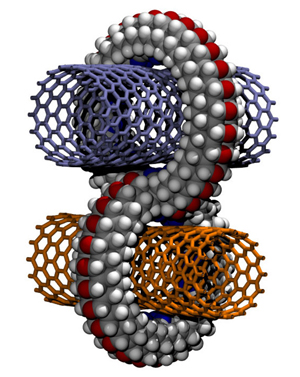While doing background research for a client on trends in nanotechnology, I became "front of the mind" aware of an increase in nanomedicine news. I have always been peripherally aware (*) of advances in nanomedicine, especially during the years I spent as Editor of Nanotechnology Now, and most recently while helping create the NanoTumor Center website. Now, however, recent news of discoveries, animal trials, and an array of new possibilities in screening, diagnosis, monitoring and treatment of disease are forcing a new level of awareness.
Here are just a very few of the telling items crossing my desk recently:
The most widespread and common method of screening DNA is called gel electrophoresis. Each test takes 1 hour and can cost as much as $1.00. Setting up a lab for gel electrophoresis requires a capital expenditure of $5,000. By contrast, Professor Rothberg's technique only requires 5 minutes, and it costs approximately $0.05 (literally five cents) per test. The capital expenditure to set up a lab with the new technique is only $600.
More here
http://www.physorg.com/news87445263.htmlResearchers at the University of Twente, in the Netherlands, have developed an ultrasensitive sensor that could potentially be used in a handheld device to, within minutes, detect various viruses and measure their concentration. The sensor could be used to quickly screen people at hospitals and emergency clinics to control outbreaks of diseases such as SARS and the bird flu.
More here
http://www.technologyreview.com/Nanotech/18028/In the first experiment of its kind, investigators at the Center for Cancer Nanotechnology Excellence Focused on Therapy Response (CCNE-TR), based at Stanford University, have shown that single-walled carbon nanotubes (SWCNTs) wrapped in poly(ethylene glycol), or PEG, can successfully target tumors in living animals.
More here
http://nano.cancer.gov/news_center/nanotech_news_2007-01-8a.aspGlioblastoma multiforme is among the most aggressive and difficult cancers to treat. Now, researchers at Penn State University have shown that a lipid-based nanoparticle, designed to bind to a specific receptor found on malignant brain cells but not healthy ones, improves the potency of a common anticancer drug and slows significantly the growth of glioblastoma in mice.
More here
http://nano.cancer.gov/news_center/nanotech_news_2007-01-8e.aspBy combining a quantum dot with a novel carrier of the magnetic resonance imaging (MRI) agent gadolinium, a team of investigators at the University of Maastricht, in The Netherlands, has developed a nanoparticle that can spot apoptosis, or programmed cell death, using both MRI and fluorescence imaging.
More here
http://nano.cancer.gov/news_center/nanotech_news_2007-01-8c.aspWith an eye toward developing a delivery vehicle for anticancer agents that are poorly soluble in water, a research team at Boston University and the Research Triangle Institute (RTI) has developed a biocompatible dendrimer that wraps itself around water-insoluble drugs. The investigators have used this dendrimer to create water-soluble formulations of three promising anticancer agents belonging to the camptothecin family.
More here
http://nano.cancer.gov/news_center/nanotech_news_2007-01-8b.aspIn an accomplishment that represents a significant step toward an era of rapid, inexpensive, bedside testing for cancer, researchers at the University of Virginia have developed a microfluidic device that can process human blood samples and yield diagnostic results within an hour.
More here
http://nano.cancer.gov/news_center/nanotech_news_2007-01-8d.aspAnd last, the team that I believe represents one of our best and most near-future hopes, Naomi Halas and Jennifer West:
The first in a new generation of nanotechnology-based cancer treatments will likely begin clinical trials in 2007, and if the promise of animal trials carries through to human trials, these treatments will transform cancer therapy. By replacing surgery and conventional chemotherapy with noninvasive treatments targeted at cancerous tumors, this nanotech approach could reduce or eliminate side effects by avoiding damage to healthy tissue. It could also make it possible to destroy tumors that are inoperable or won't respond to current treatment.
More here
http://www.technologyreview.com/NanoTech/17956/Read more about Halas and West in my 2003 write up, here
http://www.nanotech-now.com/2003-Awards/Best-Discoveries-2003.htmWhat you can take awayThere are a lot of our best and brightest working in this field.
Nanoscale materials are starting to make serious inroads into the screening, diagnosis, monitoring and treatment of disease.
Animal trials are underway, to be followed (if successful) by human trials.
Expect to see any nanoscale material used in medicine to be carefully scrutinized by all the usual players, many of which will be key to getting approval in both the government and public arenas.
Expect to see any nanoscale material used in medicine to be used by the usual luddite groups as their newest soap box.
And finally, expect to see nanoscale materials being used in a wide variety of screening tools, diagnostics, monitoring devices and treatments within the lifetime of today’s baby boomer generation.
In summation I’ll borrow a short and powerful quote from Naomi Halas:
Imagine if cancer could become trivial. The way we’re headed now I believe it will, and within a decade or two at most.
(*) I say peripherally aware since nanomedicine is just one of many noteworthy aspects of the rapid advances I see in nanoscale materials.










